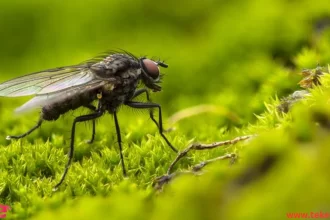It is a relatively small insect belonging to the Drosophilidae family, the arthropod phylum, and the order Diptera.
The vinegar fly is also known by many names such as fruit fly or Drosophila.
Facts about The Vinegar Fly
These flies are commonly found near rotting or unripe fruits.
The scientist Thomas Hunt Morgan was the first to use the vinegar fly for an experimental study on evolution in 1909.
Let’s learn more about it from teketrek.
The Vinegar Fly specification:
Size: The vinegar fly is relatively small.
Length: ranging from about 3 to 5 mm in length.
Color: Featuring a yellow color with black stripes.
Eyes: The eyes of the vinegar fly consist of 760 individual lenses, and two-thirds of its brain is responsible for visual processing.

What is the vinegar fly’s habitat?
Vinegar flies live all over the world, especially in tropical regions, and are most common in late summer and fall due to their attraction to fermenting fruits and vegetables.
Moist and sticky environments are where vinegar flies thrive and reproduce, such as drains, garbage cans, sewers, empty bottles, trash containers, and dirty mops.
What is the favorite food of vinegar flies
Vinegar flies are attracted to overripe or fermenting fruits, as well as to fungi or mold growing on or inside fruits.
They also feed on plant secretions and insect excretions during their pre-feeding phase.
They are most active in searching for food on bright and warm days.

FAQs about vinegar fly
How Do Vinegar Flies Reproduce?
They lay their eggs either on the rotting part of the fruit or deposit the eggs inside the fruit so that the larvae have something to eat once they hatch outside the eggs.
?Why is the vinegar fly named as such
The name “Drosophila” comes from the Greek word meaning “lover of dew,” indicating its preference for moist environments.
Its presence on vinegar, wine, and over rotting fruits is what led to this name.
What animals are considered predators of the vinegar fly?
All species of flies are considered predators of the vinegar fly, and frogs are among the most important predators of this insect, along with spiders that weave their webs to catch vinegar flies.
Why is the vinegar fly used in genetics?
Because this insect shares 75% of its genes with humans, many scientists have conducted studies on it because it has several important characteristics:
– It has a short life cycle ranging from 8 to 14 days.
– The vinegar fly can reproduce easily.
– The substances it feeds on are simple and not costly.
– Its genetic traits, such as eye color and wing length, are clearly visible.
– The vinegar fly produces large numbers of offspring, allowing for multiple replicates.
?What diseases can researchers’ study through the vinegar fly
Vinegar flies are used in studying Parkinson’s disease, Alzheimer’s disease, aging, cancer, immune diseases, as well as alcohol and drug addiction.
?Why does the vinegar fly rub its legs together
The vinegar fly rubs its legs not only for cleanliness but also for sensing. It cleans its legs to be able to sense its surroundings because its legs contain sensors that must remain exposed and clean to function effectively.
?How does the vinegar fly monitor and detect rotten fruits
Vinegar flies use their specialized sensory antennae to monitor fruit fermentation from a distance. Once the product on the table starts to exceed the ripening stage, the vinegar fly smells it from the outside and finds its way inside through the smallest cracks around the window or door.
?How many eggs does the vinegar fly produce
The vinegar fly produces approximately 30 to 50 eggs daily when the temperature is high, but in lower temperatures, it produces significantly fewer eggs.
What is the lifespan of a vinegar fly?
The lifespan of a vinegar fly is about two weeks.
In conclusion, it is important to emphasize the significance of the vinegar fly in conducting many studies and research related to human health. However, it is important to keep homes free of them as they are commonly found in places with a large quantity of fermented and ripe fruits and vegetables. We hope we have provided you with useful information, valuable facts, and amazing insights about this peculiar insect.
References:





